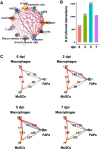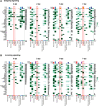Cytokine expression and cytokine-mediated cell-cell communication during skeletal muscle regeneration revealed by integrative analysis of single-cell RNA sequencing data
- PMID: 39691872
- PMCID: PMC11647049
- DOI: 10.1002/ccs3.12055
Cytokine expression and cytokine-mediated cell-cell communication during skeletal muscle regeneration revealed by integrative analysis of single-cell RNA sequencing data
Abstract
Skeletal muscles undergo self-repair upon injury, owing to the resident muscle stem cells and their extensive communication with the microenvironment of injured muscles. Cytokines play a critical role in orchestrating intercell communication to ensure successful regeneration. Immune cells as well as other types of cells in the injury site, including muscle stem cells, are known to secret cytokines. However, the extent to which various cell types express distinct cytokines and how the secreted cytokines are involved in intercell communication during regeneration are largely unknown. Here we integrated 15 publicly available single-cell RNA-sequencing (scRNA-seq) datasets of mouse skeletal muscles at early regeneration timepoints (0, 2, 5, and 7 days after injury). The resulting dataset was analyzed for the expression of 393 annotated mouse cytokines. We found widespread and dynamic cytokine expression by all cell types in the regenerating muscle. Interrogating the integrated dataset using CellChat revealed extensive, bidirectional cell-cell communications during regeneration. Our findings provide a comprehensive view of cytokine signaling in the regenerating muscle, which can guide future studies of ligand-receptor signaling and cell-cell interaction to achieve new mechanistic insights into the regulation of muscle regeneration.
Keywords: cell–cell communication; cytokines; muscle stem cells; scRNA‐seq; skeletal muscle regeneration.
© 2024 The Author(s). Journal of Cell Communication and Signaling published by John Wiley & Sons Ltd.
Conflict of interest statement
The authors declare that they have no conflict of interest.
Figures








Similar articles
-
Single-cell RNA-seq reveals novel interaction between muscle satellite cells and fibro-adipogenic progenitors mediated with FGF7 signalling.J Cachexia Sarcopenia Muscle. 2024 Aug;15(4):1388-1403. doi: 10.1002/jcsm.13484. Epub 2024 May 16. J Cachexia Sarcopenia Muscle. 2024. PMID: 38751367 Free PMC article.
-
Large-scale integration of single-cell transcriptomic data captures transitional progenitor states in mouse skeletal muscle regeneration.Commun Biol. 2021 Nov 12;4(1):1280. doi: 10.1038/s42003-021-02810-x. Commun Biol. 2021. PMID: 34773081 Free PMC article.
-
Single-Cell Analysis of the Muscle Stem Cell Hierarchy Identifies Heterotypic Communication Signals Involved in Skeletal Muscle Regeneration.Cell Rep. 2020 Mar 10;30(10):3583-3595.e5. doi: 10.1016/j.celrep.2020.02.067. Cell Rep. 2020. PMID: 32160558 Free PMC article.
-
Muscle cell-derived cytokines in skeletal muscle regeneration.FEBS J. 2022 Nov;289(21):6463-6483. doi: 10.1111/febs.16372. Epub 2022 Feb 6. FEBS J. 2022. PMID: 35073461 Free PMC article. Review.
-
Regulatory T cells in skeletal muscle repair and regeneration: recent insights.Cell Death Dis. 2022 Aug 5;13(8):680. doi: 10.1038/s41419-022-05142-8. Cell Death Dis. 2022. PMID: 35931697 Free PMC article. Review.
Cited by
-
Heterogeneous Macrophage Activation in Acute Skeletal Muscle Sterile Injury and mdx5cv Model of Muscular Dystrophy.Int J Mol Sci. 2025 Aug 21;26(16):8098. doi: 10.3390/ijms26168098. Int J Mol Sci. 2025. PMID: 40869418 Free PMC article.
References
Grants and funding
LinkOut - more resources
Full Text Sources

